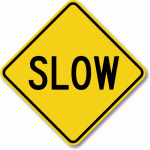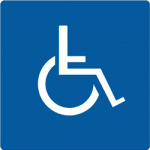In school zones, sign saturation isn’t a problem, according to study

Sign saturation isn’t the problem that some experts thought it might be, according to a recent study. Image from kennethkonica.
How does the density of traffic signage impact school safety? A new study, “Driver behavior and accident frequency in school zones: Assessing the impact of sign saturation,” investigates — and disproves — the theory that “if a driver observes too many of the same signs, he or she may no longer pay attention to those signs.” The study focuses on the effect of the number of nearby school zones on vehicle speed and compliance with those signs, and the frequency of accidents.
First, a bit of background: designating school zones is largely considered to be an effective way of reducing speed and improving safety near schools, but the impact of school zones on dropping speeds is “minimal at best,” note the study’s authors. In fact, 90 percent of drivers exceed the speed limits posted in school zones, according to studies cited by the authors; another study in Atlanta showed that school zones exerted no influence over speeding. Studies completed in certain Canadian cities found similar levels of noncompliance. Yet many drivers reported that they didn’t stop speeding because they weren’t aware they were even in a school zone.
“As a measure of the density of school zones, this study… presented a methodology to calculate sign saturation for school zones. Results found a significant effect of sign saturation on vehicle speed, compliance, and accident frequency,” explain the authors. The study also investigated drivers’ tendency to speed in school zones at different times of the day and days of the week, finding that speeding was more prevalent in the early mornings and on weekends.
In many areas, school zone signs are implemented based on political pressure or public requests, and not based on evidence that the signs’ positioning or placement reduces driver speed. Too many signs in an area may reduce driver compliance; as the study points out, “based on models of human information processing, if a driver observes too many of the same stimulus, he or she no longer attends to the stimulus with a great deal of attention.” While too many of the same signs “may lead the driver to ignore the zones altogether,” with the right “balance between novelty and oversaturation” the school zone may be an effective safety measure, note the study authors.
The study investigated “sign saturation” in school zones throughout Mississippi; using the sign inventory provided by the Mississippi Department of Transportation, the researchers calculated saturation rates for each school zone in the state. In the first part of the two-part paper, the researchers investigated driver behavior by studying four school zones’ road type (number of lanes); sign saturation level; and a few control variables. The second part focused on the impact of saturation on accident frequency within school zones.
The study discovered a number of interesting findings: first, that school zones were ineffective in lowering vehicle speed. It also found that the time of day, day of week, sign saturation and road type all exert an impact on speed and sign compliance. Drivers had the highest average speed during the overnight and morning hours, according to current data, which implies that safety interventions such as crossing guards and law enforcements are needed more during the morning school arrival, as opposed to afternoon dismissal.
The study also discovered that vehicles in in high-saturation and four-lane school zones were more likely to drive slower and to comply with signs, compared to drivers in low-saturation and two-lane school zones. The study’s results didn’t provide enough information to inform the way school zone signs are placed, but it did discover three interesting points about sign saturation in school zones:
- “There is no evidence of a negative impact of sign saturation. Place school zone signs as needed.”
- “A school zone located on a 4-lane road is more effective than a school zone located on a 2-lane road. Place school zone signs in 4-lane roads as needed.”
- “Drivers are more compliant to school zone signage in an urban setting,” evidence suggests. “Place school zone signs in urban settings as needed.”
More research is needed, point out the researchers, but their most compelling finding — that the assumption that the more signs one sees, the less likely he is to heed those signs is not true — already poses interesting implications for traffic safety near schools and beyond.
Related Posts
Category: Uncategorized

















